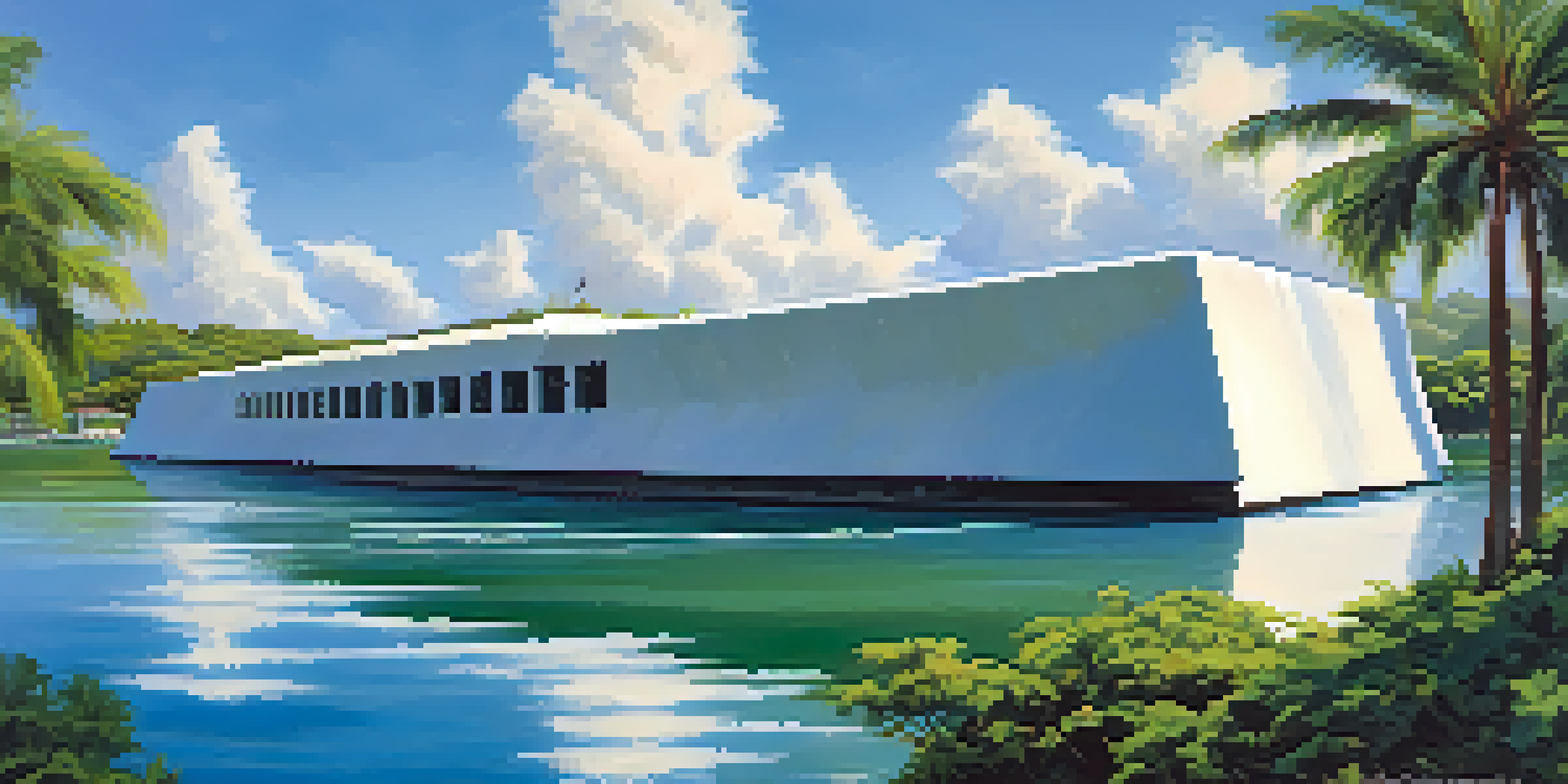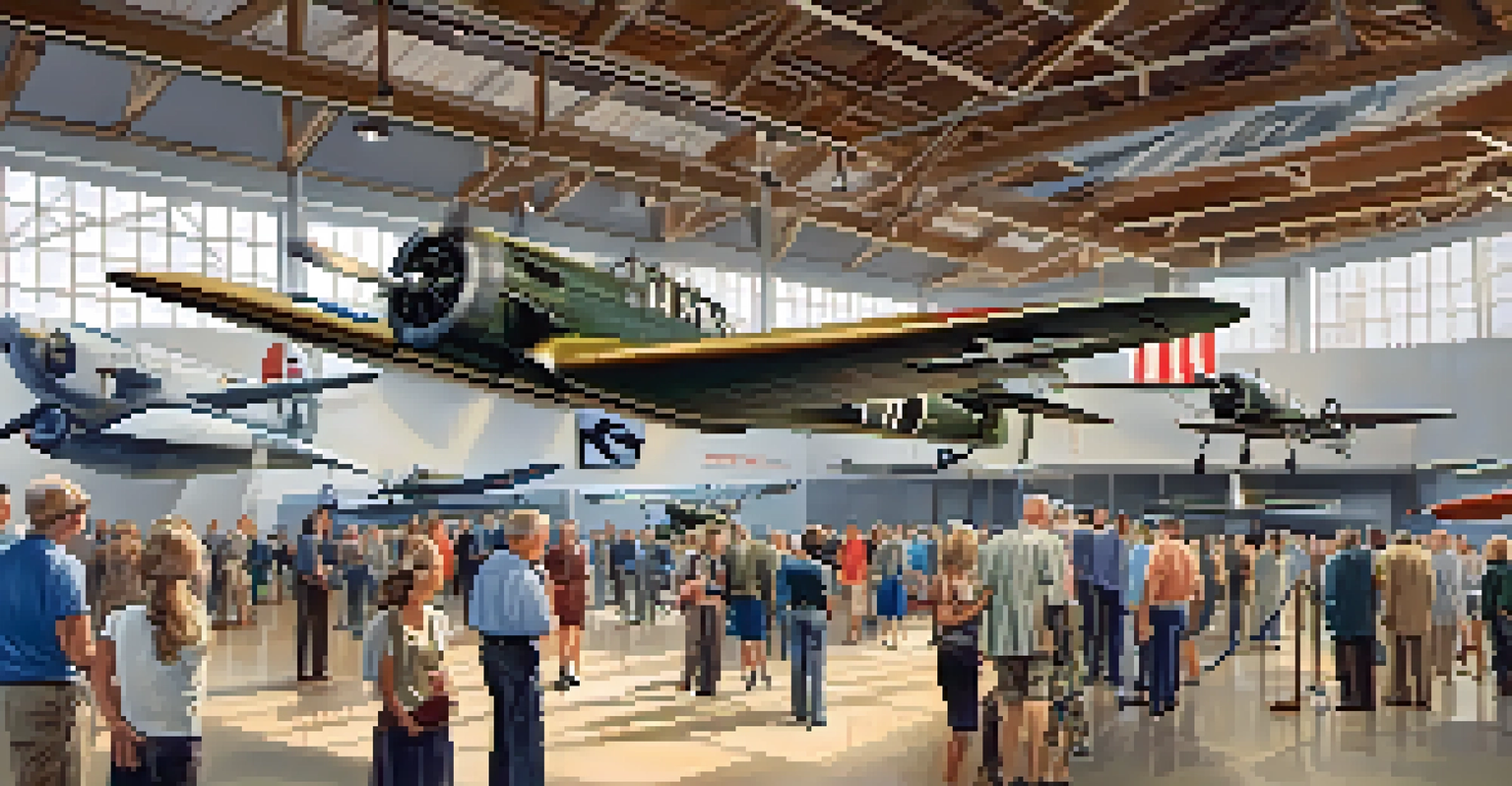Pearl Harbor: A Historic Site and Memorial in Honolulu

Understanding the Historical Significance of Pearl Harbor
Pearl Harbor, located on the island of Oahu, is a site of profound historical importance. It was here, on December 7, 1941, that Japan launched a surprise military attack against the United States, leading to America's entry into World War II. This event not only changed the course of the war but also reshaped global politics for decades to come.
Those who cannot remember the past are condemned to repeat it.
The attack on Pearl Harbor resulted in significant loss of life and damage to the Pacific Fleet, with eight battleships sunk or damaged. This tragic moment serves as a reminder of the impact of war and the importance of peace. Today, the site stands as a testament to resilience and remembrance, honoring those who served.
Visitors to Pearl Harbor can gain insights into this pivotal moment in history through various memorials and museums. Understanding its significance helps us appreciate the sacrifices made and the lessons learned from such a critical event.
Visiting the Pearl Harbor National Memorial
The Pearl Harbor National Memorial is a must-visit for anyone wanting to learn more about this historic site. It includes the USS Arizona Memorial, which honors the sailors who lost their lives during the attack. This serene structure sits above the sunken battleship, allowing visitors to reflect on the past while surrounded by the beauty of the harbor.

In addition to the USS Arizona Memorial, the site also houses several other important landmarks, including the Battleship Missouri and the Pacific Aviation Museum. Each of these attractions provides unique perspectives on the events that unfolded during World War II, making for an enriching experience.
Pearl Harbor's Historical Impact
The attack on Pearl Harbor on December 7, 1941, marked a pivotal moment in history, leading to the U.S. entry into World War II and lasting changes in global politics.
Visitors are encouraged to take guided tours or participate in educational programs to deepen their understanding of the events of December 7, 1941. Such immersive experiences bring history to life, allowing guests to connect with the stories of bravery and sacrifice.
The USS Arizona Memorial: A Symbol of Sacrifice
The USS Arizona Memorial is perhaps the most iconic structure at Pearl Harbor. Built over the remains of the sunken battleship, it serves as a poignant reminder of the lives lost during the attack. The memorial's design, which features a white structure floating above the water, represents peace and hope.
In war, there are no unwounded soldiers.
Visitors to the memorial can view the remains of the USS Arizona through the memorial’s viewing windows. This powerful sight evokes a deep sense of loss and reflection, reminding us of the sacrifices made during the war. The wall of names, inscribed with the names of those who perished, adds a personal touch to the memorial.
Attending a brief program at the memorial can further enhance your visit. Park rangers share stories of the ship and its crew, providing context that enriches the visitor experience.
Exploring the Battleship Missouri
The Battleship Missouri, also known as 'Mighty Mo,' is another highlight of the Pearl Harbor experience. This battleship played a significant role during World War II and is famous for being the site of the Japanese surrender in 1945. Exploring its decks offers a glimpse into the life of sailors during wartime.
Visitors can take guided tours of the ship, learning about its history and what life was like on board. The ship's size and the technology of the time are truly impressive, providing a tangible connection to the past. The knowledgeable guides share anecdotes that bring history to life, making it an educational experience.
Memorials Promote Reflection
The Pearl Harbor National Memorial and its various attractions encourage visitors to reflect on the sacrifices of those who served during the war and the importance of peace.
Standing on the deck of the USS Missouri, with views of the harbor, is a powerful moment for many visitors. It allows for reflection on the sacrifices made and the importance of maintaining peace in the world.
The Pacific Aviation Museum: A Journey Through Air Warfare
The Pacific Aviation Museum, located on Ford Island, is a fantastic addition to your Pearl Harbor visit. This museum showcases the history of aviation in the Pacific Theater during World War II, featuring restored aircraft and interactive exhibits. It's a great place to learn about the role of air power in the conflict.
Walking through the museum, you can see iconic planes, including fighter jets and bombers, which played critical roles in battles across the Pacific. The displays are informative and engaging, catering to aviation enthusiasts and history buffs alike. It's fascinating to learn how aviation technology evolved during the war.
For a more immersive experience, consider participating in one of the museum's flight simulation programs. This hands-on activity allows visitors to understand the challenges pilots faced, making history feel more immediate and relatable.
Lessons Learned from Pearl Harbor
Pearl Harbor serves as a poignant reminder of the unpredictability of war and the importance of vigilance. The attack caught the United States off guard, leading to significant changes in military strategy and national security policies. Studying these lessons can help prevent similar surprises in the future.
The memorials and museums at Pearl Harbor encourage visitors to reflect on the consequences of conflict and the value of peace. They remind us of the sacrifices made by service members and the importance of honoring their legacy. Engaging with history can inspire a commitment to peace and understanding.
Planning Your Pearl Harbor Visit
Visitors should allocate sufficient time to explore Pearl Harbor's memorials and museums, enhancing their experience through thoughtful engagement with the site's history.
As we remember Pearl Harbor, we must also embrace the lessons it offers for future generations. By fostering dialogue and understanding, we can work towards a more peaceful world, ensuring that the sacrifices made are not forgotten.
Planning Your Visit to Pearl Harbor
If you're planning a trip to Pearl Harbor, it's essential to set aside ample time to explore the various sites and exhibits. The National Memorial and museums can easily take a full day to visit, so planning ahead is key. Consider booking tickets in advance, especially for the USS Arizona Memorial, as they can sell out quickly.
Be prepared for a mix of indoor and outdoor activities, as some exhibits are outside. Wearing comfortable shoes and checking the weather forecast will enhance your experience. Also, consider bringing a camera to capture the stunning views of the harbor and memorials.

Lastly, take the time to truly absorb the stories and history shared at Pearl Harbor. Engaging with the exhibits and reflecting on their significance can create a more meaningful visit, leaving you with a deeper appreciation for this historic site.